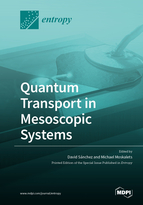Quantum Transport in Mesoscopic Systems
A special issue of Entropy (ISSN 1099-4300). This special issue belongs to the section "Quantum Information".
Deadline for manuscript submissions: closed (15 December 2019) | Viewed by 65821
Special Issue Editors
Interests: quantum transport; quantum thermodynamics; thermoelectrics; spintronics; strongly correlated systems; language variation and change
Special Issue Information
Dear Colleagues,
Mesoscopic physics has now become a well-established, mature field. The techniques developed in the 1980s and 1990s to understand electronic transport in small conductors form a standard toolbox that is available for theoreticians and experimentalists alike. Importantly, the electrical properties of mesoscopic conductors happen to be governed directly by the quantum properties of carriers, hence the term “quantum transport”. However, the advent of new materials with exotic properties poses serious challenges for the understanding of novel phenomena using standard formalisms. Further, today’s possibility of designing different setups and measurement schemes offers the opportunity of investigating transport effects lying at the interface between condensed matter, thermodynamics, and quantum information. This issue attempts to review recent trends in quantum transport and mesoscopics with a rich variety of topics: nanoscale heat and dissipation, coherent single-electronics, semiconductor spintronics, topological quantum matter, quantum Hall effects, graphene structures, strongly interacting systems, noise and fluctuations, etc.
Dr. David Sánchez
Dr. Michael Moskalets
Guest Editors
Manuscript Submission Information
Manuscripts should be submitted online at www.mdpi.com by registering and logging in to this website. Once you are registered, click here to go to the submission form. Manuscripts can be submitted until the deadline. All submissions that pass pre-check are peer-reviewed. Accepted papers will be published continuously in the journal (as soon as accepted) and will be listed together on the special issue website. Research articles, review articles as well as short communications are invited. For planned papers, a title and short abstract (about 100 words) can be sent to the Editorial Office for announcement on this website.
Submitted manuscripts should not have been published previously, nor be under consideration for publication elsewhere (except conference proceedings papers). All manuscripts are thoroughly refereed through a single-blind peer-review process. A guide for authors and other relevant information for submission of manuscripts is available on the Instructions for Authors page. Entropy is an international peer-reviewed open access monthly journal published by MDPI.
Please visit the Instructions for Authors page before submitting a manuscript. The Article Processing Charge (APC) for publication in this open access journal is 2600 CHF (Swiss Francs). Submitted papers should be well formatted and use good English. Authors may use MDPI's English editing service prior to publication or during author revisions.








